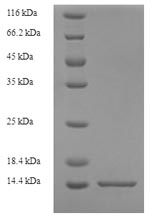Forge ahead in your immunological research with our Recombinant Rat Protein S100-A8, a key player in various cellular processes such as calcium binding and cell migration inhibition. This vital protein, part of the S100 protein family, is known for its profound implications in studies relating to inflammation and disease processes. Bring precision and reliability to your experimentation with our high-quality product.
Synthesized using an E.coli expression system, our Recombinant Rat Protein S100-A8 provides full length coverage of the mature protein, from the 2nd to the 89th amino acid. For your convenience, the protein comes with an N-terminal 6xHis-tag, simplifying its purification and detection process. Through SDS-PAGE analysis, we assure a purity exceeding 90%, underlining our commitment to delivering exceptional quality. Choose the format that best suits your needs, a ready-to-use liquid or a lyophilized powder. Trust in our Recombinant Rat S100-A8 to bolster your research with consistent, high-quality results.






